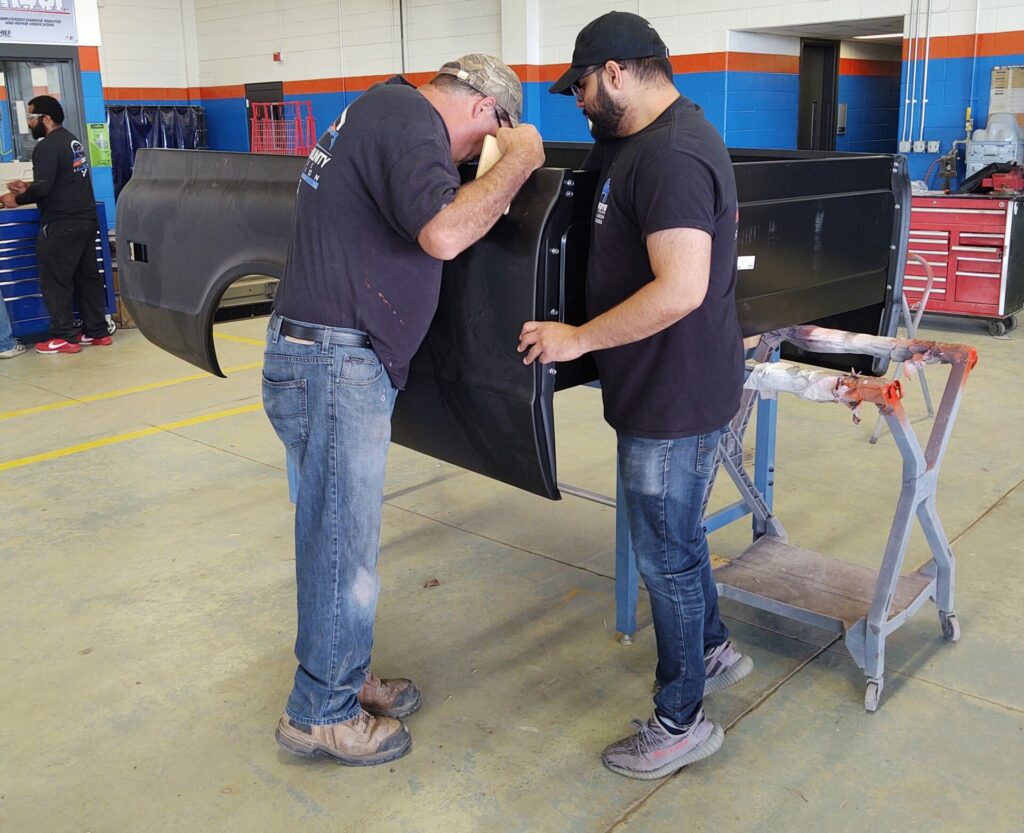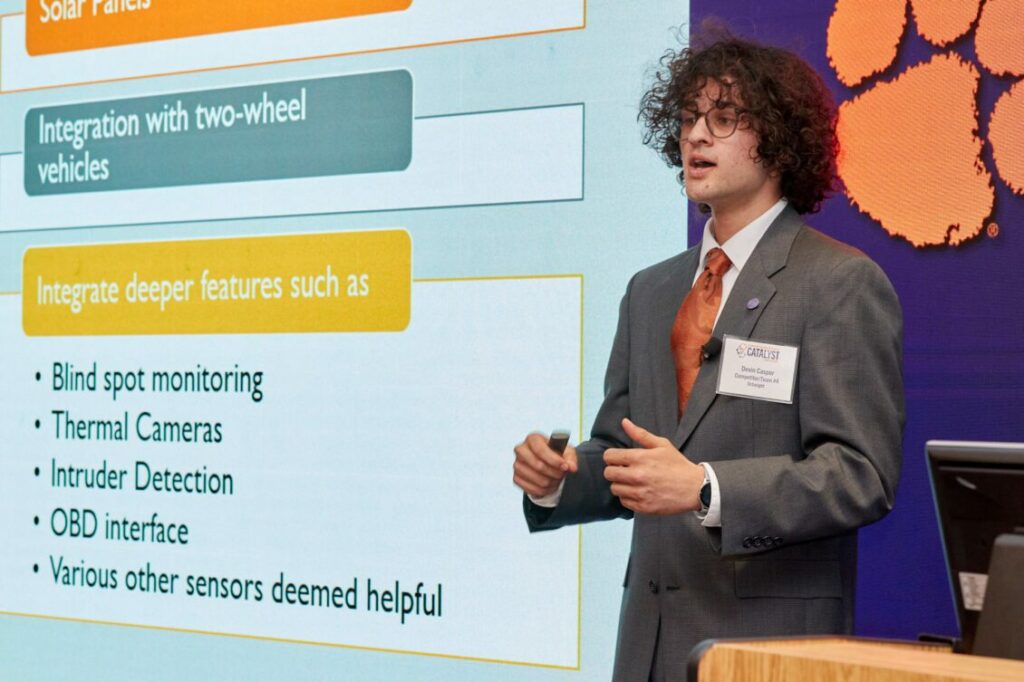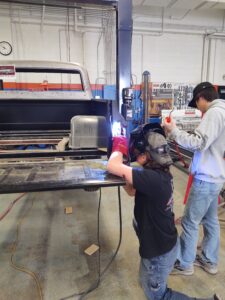
Iowa students dig deep into learning body work, South Carolina students invent vehicle safety system
By onEducation
Two colleges, one in Iowa and the other in South Carolina, have come up with creative ways of pulling students into the collision repair and automotive industry.
Hawkeye Community College’s 13 Auto Collision Technologies students are currently restoring a 1972 Chevy C10 from the ground up, including shortening the frame to install a short bed. 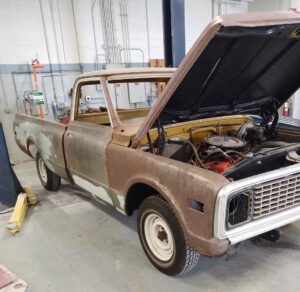
“It gives them another career choice when they get out there,” said Terry Van Dyke, Hawkeye collision repair and refinishing instructor. “I always tell them I built turn-key street rods and customs back in the ’80s and we built frames, we built our own suspensions, and the whole works.
“I always tell them it’s wise to start off in the collision industry because that’s where you’re going to pick up a lot of stuff you’re going to need when you do a restoration. [They’ll be] able to get a panel that’s thin sheet metal on these new cars straight without a whole lot of filler use. That’s really going to come in handy when you do a project car of your own, too.”
Student Liam Wagenknecht told RDN cars have been a passion of his since a young age.
“It was always something that fascinated me and it was something that was just knew that I wanted to understand more,” he said. “The whole process, collision-wise, is entirely new to me. I would say pretty much absolutely everything we’ve been able to do has been a great learning experience for me. I enjoy the tedious work that it brings sometimes because the reward is so much bigger to me to be able to sit and work on something forever or patch something up on something I’ve never done before.”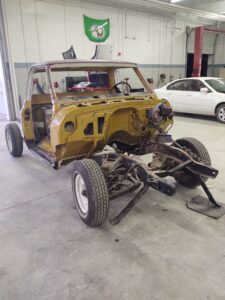
Ryan King said he picked up the love of automotive body work from his dad and uncle. “I just figured I might as well go to school for it. I wanted to be a technician and own my own shop, eventually.
“It’s been pretty cool to learn some of this stuff because I haven’t really done or messed with at all. Like some of the stuff we’ve done with the suspension and everything and putting the rear axle in. I’ve never done a motor swap before.”
Similarly, Hunter King grew up seeing his dad and grandpa work on classic cars. “I always thought it was kind of interesting… I always kinda wanted to learn how to do it so that’s why I’m here.”
Wagenknecht added that the hands-on work offered through Hawkeye’s program takes away a lot of the intimidation of the work for him.
“By the time we get out there, nothing or some things or minute things will be new,” he said.
Fuller added that the project is especially helpful for his future career because he wants to also do custom and restoration work. Wagenknecht, Fuller, and King all plan to be collision body techs.
In general, with all the cars his students work on, Van Dyke pairs his students up to teach them teamwork and usually designates one as the project lead.
For example, Van Dyke has them currently working on a 2012 Honda Civic with the lead doing the body work, and her teammate will paint it while other students work on the C10 restoration.
The C10 has been stripped all the way down, including the frame taken apart. A custom suspension has been added and it will have vintage air in it. The 13 students in the program are working right now on stripping the cab for epoxy primer prior to body work.
Hawkeye will debut the custom C10 at Good Guys Rod & Custom Association’s Heartland Nationals in 2024 so the next class of students in the fall will get to finish up the truck where the current ones leave off when they graduate. The C10 will then be used to promote Hawkeye’s program and later auctioned off with the money going back into the program and to fund another project car.
Students will also get the opportunity to work on newer vehicles including the new Ford Mach-E and a newer model Lincoln. Van Dyke said the student learn about estimating and OEM repair procedures through Mitchell International’s estimating system and use tools and paint booths that are used in the industry. They also receive metal MIG welding certification through I-CAR.
In South Carolina, at Clemson University, two students developed the “Octasight Automotive Safety System,” which is a wireless, interactive hub-based system of eight lidar sensors that alerts drivers of obstacles before they hit them, according to a Clemson news release. The sensors are on each corner and side face of the vehicle. The device has an integrated charging dock. The main hub displays data and provides visual and tactile alerts to the driver.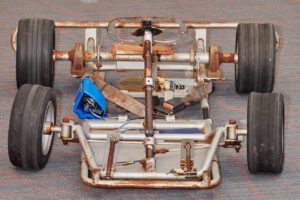
“Sixty percent of Americans are driving without these features,” Casper said.
Casper and Spina want to take their product to market, primarily catered to drivers of cars without sensor systems and parents of young drivers who want that extra layer of protection for their children. Spina said other features could be integrated into Octasight in the future, including blind spot monitoring, thermal cameras and intruder detection.
The inspiration for the project came from a crash first-year mechanical and computer engineering student Devin Casper was in with his brother. Casper’s 2010 Suburu WRX STi wasn’t equipped with an advanced driver assistance system (ADAS) commonly found in vehicles today that alert drivers if they are about to hit something.
“We were lucky. Neither of us was hurt,” Casper said. “But it got me thinking of ways to improve the safety of older cars.”
He and his roommate Soren Spina, a first-year biochemistry student, turned their vehicle safety concerns into the winning idea in the College of Science’s Catalyst Competition. The competition was launched in 2021 and is a two-semester program that supports participating student teams through entrepreneurial-related educational workshops, professional consultants and faculty advisers.
Images
Featured image: Hawkeye students complete welding for the new tail light installation. (Credit: Hawkeye Community College)
A 1972 Chevy C10 was brought into Hawkeye Community College’s Auto Collision Technologies shop for a full teardown and restoration. (Credit: Hawkeye Community College)
The C10 sits in the shop with its engine, transmission, front end, doors and bed removed. (Credit: Hawkeye Community College)
The C10’s bed is prepped for refinishing. (Credit: Hawkeye Community College)
The first prototype of Octasight was a rusty go-kart frame equipped with a sensor. (Credit: Clemson University)
Devin Casper explains how Octasight, a navigation assistance device, can help drivers avoid collisions during the College of Science’s Catalyst Competition on March 15, 2023. (Credit: Clemson University)

